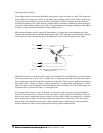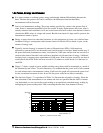
Electro Industries/GaugeTech
Doc # E107706 V1.25 1-1
Chapter
1
Three-PPhase
Power
Measurement
This introduction to three-phase power and power measurement is intended to provide only a brief
overview of the subject. The professional meter engineer or meter technician should refer to more
advanced documents such as the EEI Handbook for Electricity Metering and the application standards
for more in-depth and technical coverage of the subject.
1.1:
Three-PPhase
System
Configurations
Three-phase power is most commonly used in situations where large amounts of power will be used
because it is a more effective way to transmit the power and because it provides a smoother delivery
of power to the end load. There are two commonly used connections for three-phase power, a wye
connection or a delta connection. Each connection has several different manifestations in actual use.
When attempting to determine the type of connection in use, it is a good practice to follow the
circuit back to the transformer that is serving the circuit. It is often not possible to conclusively
determine the correct circuit connection simply by counting the wires in the service or checking
voltages. Checking the transformer connection will provide conclusive evidence of the circuit
connection and the relationships between the phase voltages and ground.
1.1.1: Wye Connection
Q
The wye connection is so called because when you look at the phase relationships and the winding
relationships between the phases it looks like a wye (Y). Figure 1.1 depicts the winding relationships
for a wye-connected service. In a wye service the neutral (or center point of the wye) is typically
grounded. This leads to common voltages of 208/120 and 480/277 (where the first number represents
the phase-to-phase voltage and the second number represents the phase-to-ground voltage).
Q
The three voltages are separated by 120
o
electrically. Under balanced load conditions with unity
power factor the currents are also separated by 120
o
. However, unbalanced loads and other
conditions can cause the currents to depart from the ideal 120
o
separation.
Phase A
Phase B
Phase C
Figure 1.1: Three-Phase Wye Winding


















